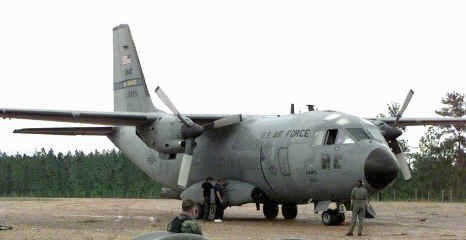The US Army is searching for a new Multi-Mission
Medium Tactical Transport (M3T2), to replace ageing C-23 and C-26 aircraft.
After the US Air Force was formed in 1947, the
Army agreed not to operate fixed-wing aircraft. Exceptions have appeared
over the years with VIP aircraft, signal intelligence aircraft, and in the
Army National Guard's C-23 and C-26 aircraft. The Army is also looking for ways to support
expeditionary airfields for rapid deployment forces, and more tactical
fixed-wing transports are part of the solution. Unless the US Air Force
wishes to fund and man fixed-wing medium-lift aircraft needed by the Army, it
should formally agree that the Army can operate any propeller aircraft. The Special
Operations Command has a requirement for similar aircraft and is likely to buy
whatever the US Army chooses.
The leading contender is the Alenia/Lockheed Martin C-27J "Spartan", which is basically a small C-130 with just two engines. This latest model has the same cockpit and engines/props as the new C-130J, so that makes it attractive. The US Air Force operated ten C-27As (right) from Panama for several years, but phased them out in 1999. It was expensive to maintain a unique aircraft in such small numbers. In addition, it required the same crew/ground support as a C-130 which can haul twice as much twice as far. The only advantage was that C-27s could land on smaller airfields on rare occasions when that was required, otherwise C-130s are much better.
Army planners should reach the same conclusion. A new C-130J can carry twice the payload twice as far as a C-27J. The only advantage is that the C-27 can operate from smaller airfields. However, a C-130J can operate from small airfields if it carries a small load. A half-loaded C-130J with a payload/fuel load of 20,000lbs requires a runway just a few hundred feet longer than a fully loaded C-27J with a payload/fuel load of 20,000lbs. Therefore, Army planners should conclude that C-130Js can provide twice more support than C-27Js for nearly the same price.
However, the Army can gain a
new capability if it procures a medium-lift fixed-wing aircraft that can operate from Navy
aircraft carriers. The US Navy already operates such an aircraft, the C-2
Greyhound. (below) It is roughly the same size as the
C-27J with the same capabilities. It could be upgraded with newer Allison engines/props like those
used by the new C-130Js. This can provide the Army with a tremendous capability
at a lower cost. While the unit cost may be higher for a
carrier capable aircraft, the total cost ownership will be much less since the
Army can rely on the Navy for spare parts procurement management, a worldwide
parts distribution system, and air crew schools. While the C-2 is not
currently in production, its sister, the E-2C ,
remains in production for the Navy.
,
remains in production for the Navy.
The problems of establishing expeditionary airfields are lessened as an aircraft carrier can provide Greyhound fuel and spare parts. Yes, the Navy may gripe, but their carriers are of limited use in most conflicts, which is why one was cleared of its Navy aircraft for full-time use by the Special Operations Command during operations in Afghanistan in 2001. The joint unified theater commander can ensure Navy cooperation and see the Navy is reimbursed for supporting Army operations. Likewise, the Navy can request support from Army C-2s should it become involved in major naval operations. The US Marine Corps should also see the wisdom of C-2s and buy a squadron for each air wing.
Army, Marine Corps, and Special Ops Greyhounds could operate from rugged expeditionary airfields. The most common mission would be to fly out the sick, wounded, and outgoing mail to an aircraft carrier, fuel up, and then return with replacements and supplies. An aircraft carrier can also by serve as a pit stop to double their range as Greyhounds fly supplies from distant staging bases in the region. In addition, C-2s are better for inserting airborne reconnaissance teams and pathfinders than bigger C-130s as they attract less attention and are harder to shoot down. A squadron of C-2s is essential for the 82nd Airborne division as it lacks a realistic method for evacuating wounded and rescued civilians. An aircraft carrier offshore has a first-class medical facility, whereas a C-130 may have to fly thousands of miles to the nearest friendly hospital.
Imagine an aircraft carrier ordered to disembark its traditional "sea control" carrier air wing and embark 30 C-2s to serve as a logistics base. If this were done in a peacetime exercise, joint planners would be stunned by this instant logistics capability. On a modest scale, the Army should seek space aboard each aircraft carrier to deploy a pair of Army Greyhounds and store key supplies for contingencies. In recent years, aircraft carriers have deployed with around 20 fewer aircraft due to soaring aircraft costs, and 1000 fewer crewmen by automating many crew functions. Therefore, aircraft carriers have plenty of room for soldiers, equipment, and more C-2s. The Army and Navy would benefit if the Army deployed a couple C-2s aboard each aircraft carrier, along with several support and logistics personnel.
The Army could even deploy a company of paratroopers aboard each aircraft carrier. They could help with ship security and provide a rapid strike force. A six-month deployment overseas aboard ship would be a real morale booster for soldiers. This should be a role for US Marines, but most of their deployed infantrymen are committed to "occupying" Okinawa. Army C-2 Greyhounds are a simple and inexpensive joint transformational idea which can add tremendous capability.
Carlton Meyer editorG2mil@Gmail.com
©2004 www.G2mil.com